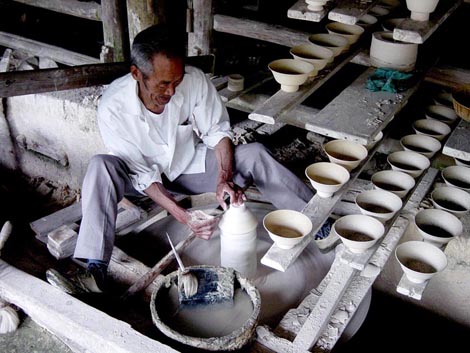
When I was young, I used to hear the phrase: “He’s like a bull in a China shop”. I’m talking about china — no, not the country, but the ceramic, porcelain, material that the word China has also been used to describe. On my recent visit to the Jiangxi Province, I ended up in the most real and most authentic China China Town of them all — a little known city by the name of Jingdezhen, known for precisely that – china.

There is more china made in Jingdezhen (otherwise known as Jingde) than in the rest of China alone. Jingdezhen is a prefecture-level city, previously a town, in northeastern Jiangxi province with a population of roughly 1.6 million. It is known as the “Porcelain Capital” because it has been producing quality pottery for 1,700 years. And, the city is even older, with a well-documented history that stretches back over 2,000 years.

Above, one of the street in Jingdezhen with nothing but ceramic shops on it and yet not a single tourist in sight.

During the Han Dynasty, Jingdezhen was known as Xinping. Historical records show that it was during this time that it began to make porcelain. Xinping then was renamed Changnanzhen (Changnan Town) during the Tang Dynasty since it sits at the south bank of Chang river. And “china” is translated from “Changnan”. In 1004 CE during the North Song Dynasty, it was renamed again as Jingdezhen, taking the era name of the emperor during whose reign its porcelain production first rose to fame.
In the Ming and Qing dynasties, Jingdezhen was named one of four famous towns in Chinese history, along with Foshan (Guangdong), Hankou (Hubei) and Zhuxianzhen (Henan). Allegedly, Jingdezhen gave birth to the English name of the country. The ancient name of the town is Changnan. Far back in time, Changnan was synonymous with ceramics, and over time, foreign ceramics traders made the name sound like “china”. Of course the rest is history.
Jingdezhen was named one of top 24 national historical and cultural cities of the People’s Republic of China on February 28, 1982 and in 2004, Jingdezhen celebrated the millennium of its becoming the porcelain capital and its assuming its present name.
Getting to Jingdezhen:
The easiest way is by bus from Nanchang from the Nanchang bus station. Be sure to write the names of the places in Chinese when booking tickets as always. Our bus was 79 RMB each and took around 3 hours. You can also get there by train, which is slower. Apparently Jingdezhen also has an airport.

5 Things To Do:
1. Admire the Ceramics in “Porcelain Street”
Walk around the shops selling and displaying their proud ceramic products on a street which is literally known as “Porcelain Street”.

2. People’s Square
This wide open square and park is popular with locals for family and get togethers and is a great place simply to relax on a day out. There are a few large ceramic models displaying the pride within the city of its most famous products.
3. Yaoli Scenic Area
Waterfalls, a forest and Huizhou architecture make Yaoli a popular trip out of the main city of Jindezhen. There are old style buildings, countryside and mountains on the border between the town Chinese Provinces of Jiangxi and Anhui.
4. Jingdezhen Ceramic Museum
If you want a closer insight into the history and present day details on the ceramics and the region, visit the Jingdezhen Ceramics Museum and a local bus tour will help organize it.
5. Countryside at Wuyuan
After getting your fix of Jingdezhen, head to the fantastic countryside in and around Wuyuan, which is about an hour and a half from Jingdezhen. Notables: Be sure to drink wine in Xiaoqi and drink coffee in Little Likeng.

Out in the villages near Wuhan – this is Little Likeng – a break away from Jingdezhen.
Jingdezhen despite being the famous home of China is merely a typical Chinese city which has been successful from tourism — local tourism that is since there really are very few foreign tourists. There’s no question, the city is communist China to the core at heart. Below, a video from Jingdezhen:
Top photo credit only: scenery.cultural-china. com

Jonny Blair is a self confessed traveling nomad who founded and blogs at Don’t Stop Living. He sees every day as an adventure. Since leaving behind his home town of Bangor in Northern Ireland ten years ago he has traveled to all seven continents, working his way through various jobs and funding it all with hard work and an appetite for travel. Don’t Stop Living, a lifestyle of travel’ contains over 1,000 stories and tips from his journeys round the globe. He wants to show others how easy it is to travel the world, give them some ideas and encourage them to do the same but most of all he aims to constantly live a lifestyle of travel. He is currently based in Hong Kong and on Twitter @jonnyblair.








